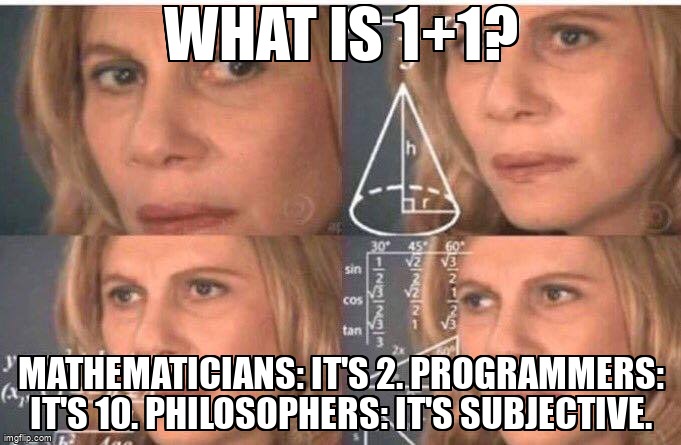Numerical Nuptials
Q: Why did the number get mad at his wife?
A: Because she was too divisive, and it really subtracted from their relationship!

Q: Why did the number get mad at his wife?
A: Because she was too divisive, and it really subtracted from their relationship!
Q: What is 1+1?
A: It depends on who you ask: a mathematician will say “2”, a physicist might consider the precision of “2.0”, and a kindergartener might just show you two fingers and then ask if it’s snack time yet!
Q: Why did the math book look so sad?
A: Because it had too many problems!
The square root of 4 walked into a bar.
The bartender said, “Two drinks coming up!”
The root replied, “You figured me out.”
A decimal went to a dance party.
Another number asked, “Why don’t you settle down?”
The decimal replied, “I’m always trying to get a point across.”
Why did X go to school?
It wanted to find its value.
A right angle wrote a love letter.
It said, “Dear acute angle, you make my heart feel 90 degrees warmer.”
A triangle went to a barbershop.
The barber asked, “What kind of cut?”
The triangle said, “Just take a little off the angles.”
A circle was feeling down.
A friend asked, “What’s wrong?”
The circle replied, “I’m just going around in circles.”
Six bumped into Seven at a party.
Seven said, “Hey, buddy!”
Six replied, “Stay away! I’ve heard stories about you.”
Two parallel lines met.
One said, “Let’s be friends!”
The other replied, “Sorry, we’ll never meet.”
Why don’t math books ever get to have fun on the first day of school?
Because they’re always full of problems!
Why is 69 afraid of 70?
Because they once had a fight and 70 won!
Why did 69 take a break from its job?
It was feeling overworked – it already had too many responsibilities at home!
Why do math students like the number 69?
Because it’s a perfectly reciprocal number – it looks the same upside down!
Why did the number 69 apply sunscreen?
Because it didn’t want to turn into 70!
Why is 69 always the star at the party?
Because it’s always in the center of the number line dance!
Why don’t mathematicians ever have to solve family problems?
Because for them, all problems are as easy as “pi”!

Why was the equal sign so humble?
It knew it wasn’t less than or greater than anyone else!
Q: Why did the two 4’s skip dinner?
A: Because they already 8!
Q: What do you call a man who spent all summer at the beach?
A: A tangent. Because he’s been sun-tanning all summer long and can’t stop going off on tangents about it.
Q: Why was the calculator a great gossip?
A: Because it knew all the operations and could always count on the latest functions.
Q: Why was the number π upset?
A: Because it felt like it was being irrationally criticized!
Why was the math book sad?
It had too many problems, and none of them could be solved with a magic wand!
Theorem: All positive integers are interesting.
Proof: Assume the contrary. Then there is a lowest non-interesting positive integer. But, hey, that’s pretty interesting! A contradiction.
The ark lands after The Flood. Noah lets all the animals out. Says, “Go and multiply.” Several months pass. Noah decides to check up on the animals. All are doing fine except a pair of snakes. “What’s the problem?” says Noah. “Cut down some trees and let us live there”, say the snakes. Noah follows their advice. Several more weeks pass. Noah checks on the snakes again. Lots of little snakes, everybody is happy. Noah asks, “Want to tell me how the trees helped?” “Certainly”, say the snakes. “We’re adders, and we need logs to multiply.”
What is “pi”?
Mathematician: Pi is thenumber expressing the relationship between the circumference of a circle and its diameter.
Physicist: Pi is 3.1415927plus or minus 0.00000005
Engineer: Pi is about 3.
The shortest math joke ever: let epsilon < 0 (*)
A biologist, a statistician and a mathematician are on a photo-safari in africa. They drive out on the savannah in their jeep, stop and scout the horizon with their binoculars.
The biologist : “Look! There’s a herd of zebras! And there, in the middle : A white zebra! It’s fantastic ! There are white zebra’s ! We’ll be famous !”
The statistician : “It’s not significant. We only know there’s one white zebra.”
The mathematician : “Actually, we only know there exists a zebra, which is white on one side.”
Q: What’s purple and commutes?
A: An abelian grape.
Q: What’s yellow, and equivalent to the Axiom of Choice?
A: Zorn’s Lemon.
Theorem : All positive integers are equal.
Proof :
Sufficient to show that for any two positive integers, A and B, A = B. Further, it is sufficient to show that for all N > 0, if A and B (positive integers) satisfy (MAX(A, B) = N) then A = B.
Proceed by induction.
If N = 1, then A and B, being positive integers, must both be 1. So A = B.
Assume that the theorem is true for some value k. Take A and B with MAX(A, B) = k+1. Then MAX((A-1), (B-1)) = k. And hence (A-1) = (B-1). Consequently, A = B.
What’s 72?
69 with 3 people watching!
